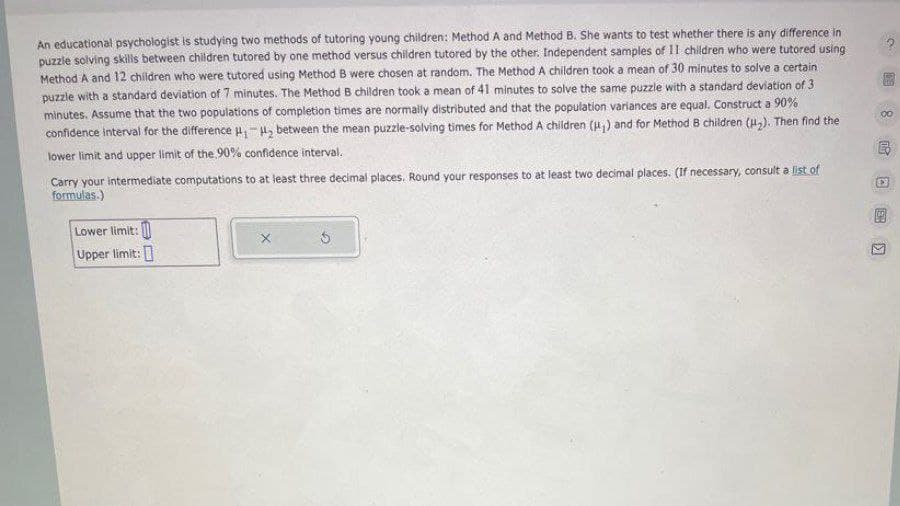An educational psychologist is studying two methods of tutoring young children: Method A and Method B. She wants to test whether there is any difference in puzzle solving skills between children tutored by one method versus children tutored by the other. Independent samples of 11 children who were tutored using Method A and 12 children who were tutored using Method B were chosen at random. The Method A children took a mean of 30 minutes to solve a certain puzzle with a standard deviation of 7 minutes. The Method B children took a mean of 41 minutes to solve the same puzzle with a standard deviation of 3 minutes. Assume that the two populations of completion times are normally distributed and that the population variances are equal. Construct a 90% confidence interval for the difference H₁-H₂ between the mean puzzle-solving times for Method A children (₁) and for Method B children (H₂). Then find the lower limit and upper limit of the 90% confidence interval. Carry your intermediate computations to at least three decimal places. Round your responses to at least two decimal places. (If necessary, consult a list of formulas.) Lower limit: Upper limit: 00
An educational psychologist is studying two methods of tutoring young children: Method A and Method B. She wants to test whether there is any difference in puzzle solving skills between children tutored by one method versus children tutored by the other. Independent samples of 11 children who were tutored using Method A and 12 children who were tutored using Method B were chosen at random. The Method A children took a mean of 30 minutes to solve a certain puzzle with a standard deviation of 7 minutes. The Method B children took a mean of 41 minutes to solve the same puzzle with a standard deviation of 3 minutes. Assume that the two populations of completion times are normally distributed and that the population variances are equal. Construct a 90% confidence interval for the difference H₁-H₂ between the mean puzzle-solving times for Method A children (₁) and for Method B children (H₂). Then find the lower limit and upper limit of the 90% confidence interval. Carry your intermediate computations to at least three decimal places. Round your responses to at least two decimal places. (If necessary, consult a list of formulas.) Lower limit: Upper limit: 00
A First Course in Probability (10th Edition)
10th Edition
ISBN:9780134753119
Author:Sheldon Ross
Publisher:Sheldon Ross
Chapter1: Combinatorial Analysis
Section: Chapter Questions
Problem 1.1P: a. How many different 7-place license plates are possible if the first 2 places are for letters and...
Related questions
Question

Transcribed Image Text:An educational psychologist is studying two methods of tutoring young children: Method A and Method B. She wants to test whether there is any difference in
puzzle solving skills between children tutored by one method versus children tutored by the other. Independent samples of 11 children who were tutored using
Method A and 12 children who were tutored using Method B were chosen at random. The Method A children took a mean of 30 minutes to solve a certain
puzzle with a standard deviation of 7 minutes. The Method B children took a mean of 41 minutes to solve the same puzzle with a standard deviation of 3
minutes. Assume that the two populations of completion times are normally distributed and that the population variances are equal. Construct a 90%
confidence interval for the difference H₁-H₂ between the mean puzzle-solving times for Method A children (₁) and for Method B children (H₂). Then find the
lower limit and upper limit of the 90% confidence interval.
Carry your intermediate computations to at least three decimal places. Round your responses to at least two decimal places. (If necessary, consult a list of
formulas.)
Lower limit:
Upper limit:
00
EX
Expert Solution
This question has been solved!
Explore an expertly crafted, step-by-step solution for a thorough understanding of key concepts.
Step by step
Solved in 3 steps with 1 images

Recommended textbooks for you

A First Course in Probability (10th Edition)
Probability
ISBN:
9780134753119
Author:
Sheldon Ross
Publisher:
PEARSON


A First Course in Probability (10th Edition)
Probability
ISBN:
9780134753119
Author:
Sheldon Ross
Publisher:
PEARSON
